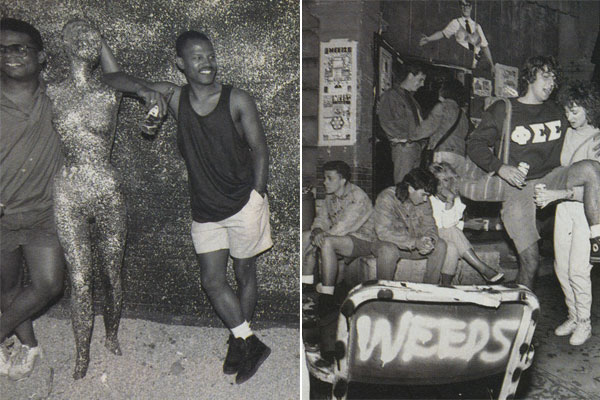
Chicago clubs, 1988: Neo and Weeds
Related:
DREAMS OF A SATURDAY NIGHT »
Fifty years of the Pump Room: satin turbans and celebrities, flaming swords and Booth One, and the unforgettable May Darling
THE BOYS OF RUSH STREET »
Friday is prime time for taking a chance on the chase. To be single and male is to prowl at a hungry pace.
ADVENTURES OF A CLUB SCOUT »
An intrepid reporter takes to the streets on a daring mission. His task: to bring back fresh reports on the secret life of the wild, wild evening.
Today marks the official reopening of the Pump Room—after a limited opening last month—the legendary bar that was opened in 1938, bought by restaurant impresario Rich Melman in 1975, closed in 2010, and was re-reinvented by upscale hotelier Ian Schrager as part of his nascent Public hotel chain. It's a storied location, but it's the nature of nightlife that the stories don't last a long time. If you want a sense of how the Pump Room became a legend—and the glamour Schrager is trying to recreate—here's a 1988 piece by Rick Kogan, well into Rich Melman's tenure: "Dreams of a Saturday Night."
The Pump Room's greatest glory, though, lies in its past. It is locked into the framed celebrity photos that fill the walls of the room’s entrance, and in the thousands of words those pictures speak: of Margaret O’Brien’s first taste of lipstick, of Barrymore blasted, Reagan and Wyman holding hands, Monroe, Bogie, and Gable.
It is locked into the memories of that fading group who knew it when . . . when that playful visionary Ernie Byfield, who wanted a “celebrity palace" and, taking his design cues from the 18th-century British watering hole and gambling spa at Bath, created that and more—a room at once outrageous and attractive. An absurd delight.
Those pictures—Michael Douglas, David Bowie, the ever-glamorous Richard Nixon—mark the club's new website.
But the Pump Room is just one facet of Chicago's nightlife, a rare beast in a city that's never supported much of a celebrity or socialite scene. Reading through old issues of Chicago, I came across a couple more looks into the night of the city from times past. First, Rick Telander (better known as the Sun-Times's sportswriting star) narrates a night on Rush Street in the company of men circa 1988:
Jack is a nice-looking young man, though certainly no male model. Mothers might pinch his cheek, but attractive young ladies are not going to grow jelly-kneed just because he happens to be standing at the next table. Like thousands, perhaps millions of other single men in the United States, Jack must present his entire image—the persona of a well-dressed, hip, fit, sincere, sensitive, intelligent, whoop-it-up yet financially responsible working man—if he hopes to get lucky with a girl. He knows that beautiful females have hormones, too. But they’re funny hormones. They don’t spring from the loins. They seem to come from somewhere deep in the ladies’ brains, back where images of romantic hand-in-hand strolls through autumn fields and babies in carriages and swollen stock portfolios and evening gowns, caviar, and lovingly tended vegetable gardens all coalesce to form a pastel canvas entitled Elegant Security.
[snip]
“With me, these serious girls are feeding oats to a dead horse. I tell them, ‘You do what you gotta do. Me, I’m not ready for marriage.’ I’m honest. I'm not looking for a wife. See, the problem is, there are more single women than guys, and if a guy is, say, 32 and single, it’s by choice. But a gal at 32 and unmarried—I mean, the pressure increases as her friends drop off one by one and she starts examining her life. . . . The dangerous ones are the ones who don’t have any stability or direction in their careers—they jump from being a waitress to bank clerk to executive secretary, then back to waitress—and when they find a guy who has a good job, good potential—boom!—they’re on you like flies on poop.”
Rush Street: it's been like this for decade upon decade.
And "Adventures of a Club Scout," from the same year, which ping-pongs from Lincoln Park to Bucktown and shows—great pictures—what my life would have looked like had I been born ten years or so earlier. Well, the Rainbo Room—Bucktown's Pump Room—is still around, at least. One thing we, as a culture, probably do miss from the '80s: absurdly conceptual bars that look like a cross between Blade Runner and a Janet Jackson video:
Esoteria is a pastiche of even more design cliches than Cristal. There's ersatz decay, Sistine Chapel reproductions, glass brick, metal cable, Jackson Pollock-inspired drippings on the floor, Day-Glo paint on the walls, and a chain-link fence surrounding one of the dance floors. The juke box up front is filled with CDs: the DJ out back plays lots of David Bowie and Talking Heads.
Just a reminder that when you go out, you're stepping into history.


